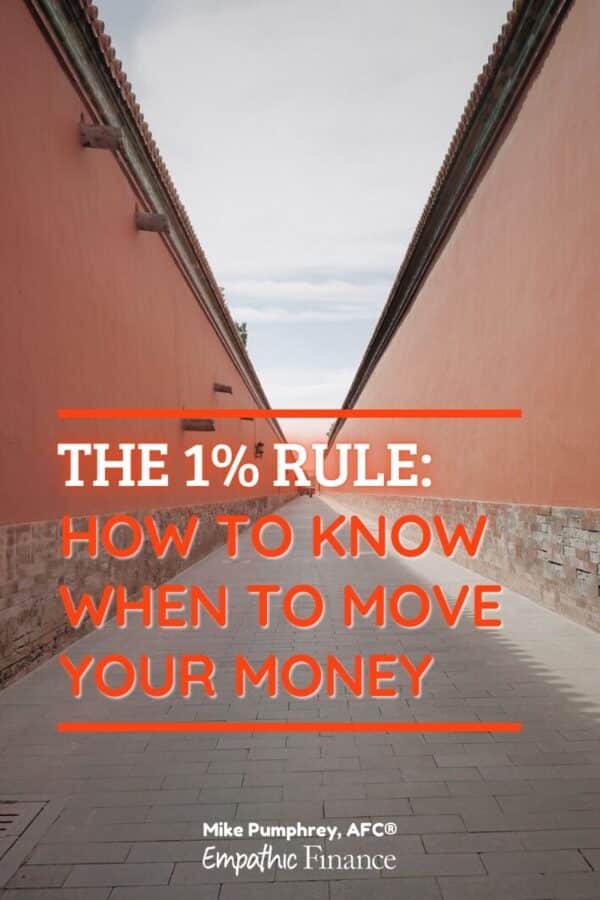Not every deal necessitates the hassle of moving your money or accounts around, but the 1% Rule is a good threshold to keep in mind.
Interest rates are high these days. How you feel about this depends on whether you’re earning more money from these rates or spending more money from these rates.
If you have a savings account, then you have the opportunity to earn money from high interest rates. However, if you’re shopping for a loan, or, worse, if you have an adjustable rate loan, then you’re going to be spending much more money from these interest rates.
If rates are moving around you, and you haven’t responded or reacted to them, you may be thinking about whether you want to do something: move your money around, move your accounts around, that sort of thing.
In general, when it comes to financial moves, I’m a fan of the phrase “don’t just do something; stand there!“. If you try to be slick, you’ll most likely end up losing your shirt.
But when do you make a move, and when do you sit still? To answer this, I came up with the idea of the 1% Rule, which should help you make some of these decisions more easily.
Table of Contents
What is the 1% Rule?
The 1% Rule states that you shouldn’t make a move on money or accounts unless there is a greater than 1% difference in interest rates.
The reason for this is that there is a cost—sometimes financial, sometimes just administrative—involved in moving money and accounts around. And it’s got to be worth the hassle.
This isn’t a hard and fast rule, of course, but it’s a good guardrail for you as you decide how to make the best of interest rate changes going forward.
Savings accounts
As rates have risen, so have interest rates on savings accounts.
Well, some of them. The big banks have let savings rates atrophy to near zero for a long time now, and I don’t expect that to change any time soon.
But other savings accounts, such as at online savings banks such as Ally, have much higher rates.
In fact, 5% or more isn’t uncommon, as you can see in this Bankrate search.
Now, 5% is significantly higher than 0.05%, a typical big bank rate. So if I were you, I would move my money from the lower rate to a bank offering the higher rate. This difference is much more than 1%, so I’d make the move.
Would I move from a place offering 4.25% to a place offering 5%? Probably not. It’s a hassle to move accounts, and the amount of money I would earn in the difference wouldn’t likely be that much.
But for greater than a 1% difference? I might make the move.
Mortgage rates
This is less of an issue right now, but in the past, mortgages rates fell. You might have been stuck with a higher rate than you could get if you were getting a new mortgage today.
So if you could get a new mortgage at a lower rate, why not refinance?
The reason why not is that it’s not free to refinance a mortgage. There are closing costs, and you’ll pay them regardless of what the new interest rates are. You need to make sure that the savings you get in interest rates is larger than the amount you pay in fees to refinance.
At the very least, you probably want to make sure that the mortgage rate is 1% lower. Otherwise, you probably not getting your money’s worth (and this is especially true if you don’t plan on staying in the home for very long).
Credit cards
These days, you can find credit card rates (APRs) of 15%, 20%, or even higher. If you carry a balance on your card with one of these rates, you probably want to find a card with a lower rate.
Because of the scale of the interest rates, it’s unlikely that you’ll find a rate that’s less than 1% different, so the 1% Rule, while certainly true, is kind of trivial here.
It’s certainly worth it to find a lower interest rate, but I also want to make sure that you’re not solely shopping around for lower interest rates. You would save far more money by taking your limited energies and paying down that credit card balance.
Rule of 1% thumb
When it comes to financial moves, you want to make sure that the benefits are worth the costs, in terms of human labor and energy, and actual financial costs too. The 1% Rule is a good rule of thumb to tell you when a move is worthwhile, or whether you should probably just hunker down and let things lie.



